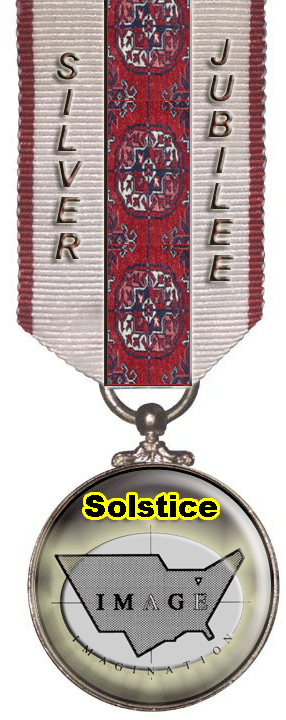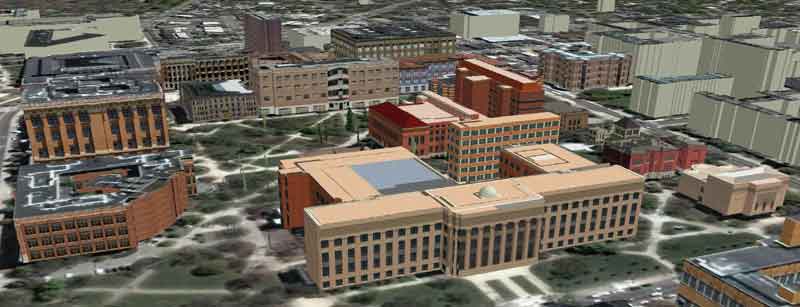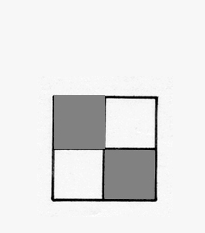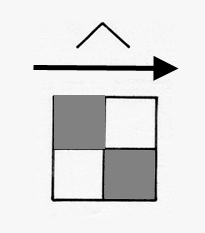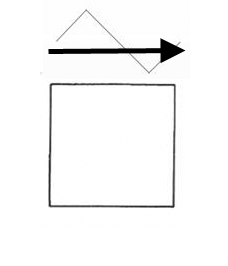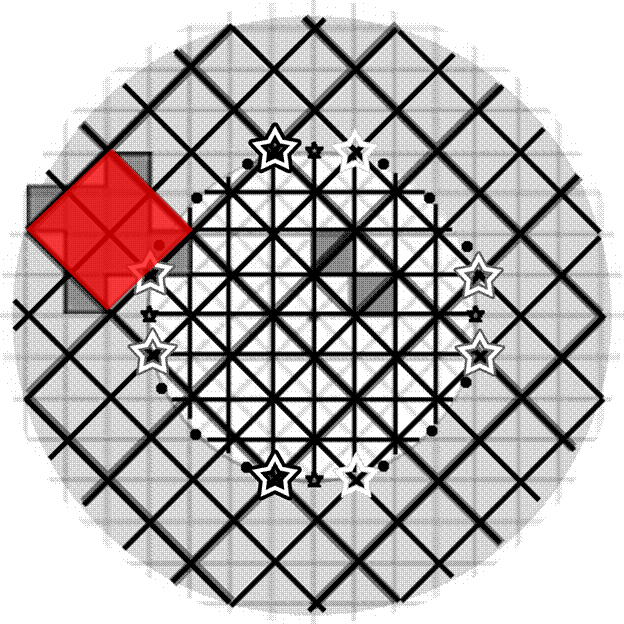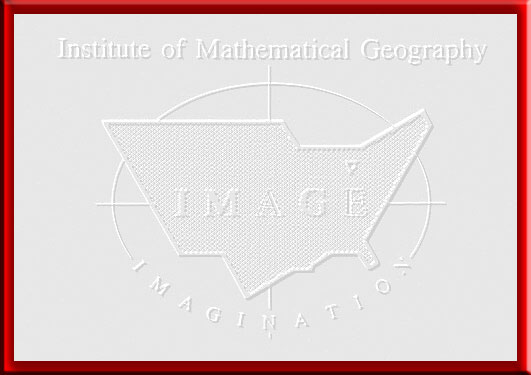Classical Generation of a Fractal
Applications of fractal geometry, in which a suitably selected
generator is applied through stages of successive iteration to an
initiator, are legion. We consider one simple case here,
generated in a classical manner, and then suggest one alternative for
its generation using another procedure. As an example, we
explore the self-similar geometry of
fractals in order to envision scaling networks to different dimensions
and
differing levels of space-filling by streets depending on surrounding
land use
types.
To
see how self-similarity might generate street
pattern, consider the application of a V-shaped generator, applied to a
square initiator,
to generate successive stages of finer and finer grid pattern (Figure
1, Arlinghaus 1985, 1990). The
animations of Figure 1
illustrates the process through successive stages of generator
application and scaling. Figure 1a illustrates the general
process while Figure 1b suggests how to visualize the detail of
application of the fractal generator. The
limiting position of such space-filling occurs when this iteration of
transformation is carried out infinitely. Using
Mandelbrot’s characterization of fractional
dimension, the
space-filling is captured as D
= log(n)/log( ),
where n is the number of
generator sides
and K is the
number of self-similar regions. Thus, in the case of Figure 1, D =
log(2)/log( ),
where n is the number of
generator sides
and K is the
number of self-similar regions. Thus, in the case of Figure 1, D =
log(2)/log( )
= 2. When the process is carried out infinitely, the entire
area over which it is carried out becomes filled with network
edges. In order to suggest network scaling and pattern, one would
wish to truncate the iterative process and stop it after a finite
number of steps, perhaps determined by smallest parcel size according
to zoning category. )
= 2. When the process is carried out infinitely, the entire
area over which it is carried out becomes filled with network
edges. In order to suggest network scaling and pattern, one would
wish to truncate the iterative process and stop it after a finite
number of steps, perhaps determined by smallest parcel size according
to zoning category.
|
Figure 1a. A
style of hierarchy generated through
self-similarity applied to a square initiator. D = 2. General
iteration sequence.
|
|
Figure 1b. Visualization of
detail of generator application in Figure 1a.
|
Changing
the generator, but keeping the same
initiator (a square) produces a different pattern (Figure 2). The
animations of Figure 2
illustrates the process through successive stages of generator
application and scaling. Figure 2a illustrates the general
process
while Figure 2b suggests how to visualize the detail of application of
the fractal generator.
Here, in the infinite process, the fractional dimension
is D =
log(3)/log( )
= (2/3)*log(3)/log(2) = 1.0619248. The
choice of the three-sided generator
produced a pattern shaped similarly to the choice of the two-sided
generator
but did so in a much less compact manner. Hence,
the space-filling of the lines and associated
fractional dimension
are less than in the previous case, suggesting orientation of street
pattern to parcel in yet another manner. Again, though, to
realize the model in relation to street networks and parcels, the
iteration would need to be truncated, presumably in relation to the
urban character of the space under consideration. )
= (2/3)*log(3)/log(2) = 1.0619248. The
choice of the three-sided generator
produced a pattern shaped similarly to the choice of the two-sided
generator
but did so in a much less compact manner. Hence,
the space-filling of the lines and associated
fractional dimension
are less than in the previous case, suggesting orientation of street
pattern to parcel in yet another manner. Again, though, to
realize the model in relation to street networks and parcels, the
iteration would need to be truncated, presumably in relation to the
urban character of the space under consideration.
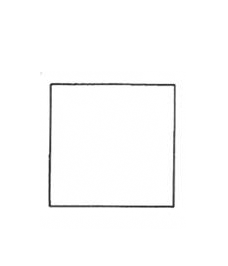
Figure 2a.
A
style of hierarchy generated through self-similarity applied to a
square initiator. The dotted lines show the polygon generated (or given
in the previous state). The solid lines
show the generated edges. The dashed lines
are inferred (but not generated) pattern. Thus,
the value of D = 1.0619248 applies only to the generated (solid)
pattern. General iteration sequence.
|
|
Figure 2b.
Visualization of detail of generator application in Figure 2a. |
Alternative
Geometric Generation of
Fractals: Eigenvalue Geometry
One
method of making direct calculations of
fractional dimension relies on using a generator applied at successive
scales
to an initial shape. Successive generator application to new
self-similar
shapes creates an infinite process that converges to some finite value
as a
fractional dimension. The previous
section showed two examples. Generator
selection, to produce a desired outcome (pattern or number) is an art.
In
this section, we reconsider the example of Figure 2 generated above
with respect to different underlying geometric
processes. With generator scaling and
creative generator
shape selection, as above, only an envelope of the associated pattern
is
generated. Advantages of the strategy
suggested below are:
·
The
full pattern, and not merely its
envelope, is generated.
·
A
systematic geometric process with
roots in linear algebra may offer interesting related connections.
A
scaling effect is evident in the process above as
the generator is successively scaled to fit polygon sides.
An alternative procedure for generating the
fractal sequence of Figure 2 employs a single shape, a “4-star graph,”
that
when translated across the plane creates the same pattern as in Figure
2. The
sequence of images in Figure 3 illustrates the process: begin with a
4-star graph
(Figure 3a), apply a shift it to the right (Figure 3b), continue
stretching to
shift the image in the same direction as the original transformation
(Figure 3c).
Then, using a shift orthogonal to the first one, apply it to a 4-star
graph to
shift it (Figure 3d), continue stretching to shift the image in the
same
direction as the original transformation (Figure 3e). Finally, use the
two
shift directions to fill in the rest of
the
space (Figure 3f).
In
a geometric interpretation of a linear algebra
context, the shift directions function as eigenvectors
of a transformation to create the
pattern when they are
applied to a 4-star graph. The eigenvalues of the transformation are
the
amounts the eigenvectors are stretched or shrunk. In this example, one
might
consider each basic eigenvector to have length 1, in which case other
eigenvalues would be the set of positive and negative integers. If,
however,
this synthetic geometric form is superimposed on some underlying
coordinate
system, then the eigenvalues might be different, although still
integral,
multiples of the basic one. Notice that the visualization of Figure 3
shows where
these vectors are “lurking” in Figure 2—they are the edges of the
polygon to
which the generator is applied!
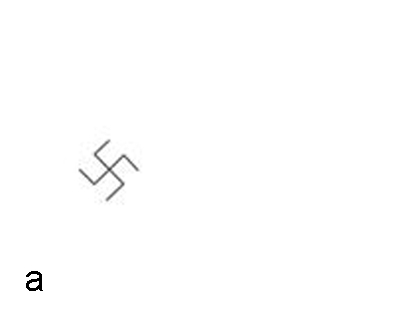
|
Figure 3.
a. Initial 4-star.
b. Vector to shift pattern.
c. Successive application of vector
d. Vertical shift.
e. Successive application of vertical vector.
f. Use of the pair of vectors to fill in pattern.
|
The
sequence in Figure 3 generates the first layer
of pattern. To illustrate how to create a subsequent layer, and all
others,
focus on a single generated polygon (teragon) from Figure 3f (shown in
Figure 4a).
Begin, again, by introducing a single small 4-star graph (Figure 4b).
Apply a vector
to transform it (Figure 4c). Continue the application in the same
direction,
positive or negative (Figure 4d). Apply an orthogonal vector to move
the 4-star
graph (Figure 4e). Continue the application of that vector in positive
and
negative directions (Figure 4f). What
causes the shifts here are the orthogonal vectors; in this case, the
art comes
in selecting the initial pattern, the 4-star, rather than in selecting
the
generator. Here, generators are directed
straight line segments.
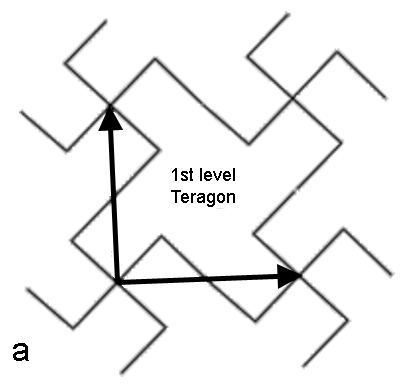
|
Figure 4.
a. Focus.
b. Initial 4-star.
c. Vector to shift pattern.
d. Successive application of vector.
e. Orthogonal shift.
f. Successive application of orthogonal vector.
|
Combinations
of the vectors in Figure 4 expand
pattern to fill space. Figure 5a shows this space filling together with
the
pattern of basic vectors in relation to each other: both orientation
and
length. Figure 5b shows that the process creates 8 scaled-down teragons
self-similar
to the first teragon. Notice that the
full pattern, and not merely its envelope, is generated by this process.
This alternative strategy is faithful to the
initial ideas involving self-similarity.
|
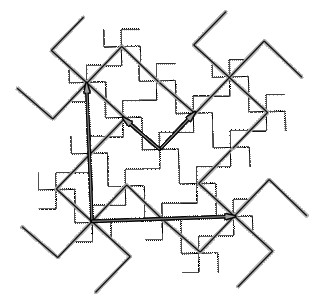
|
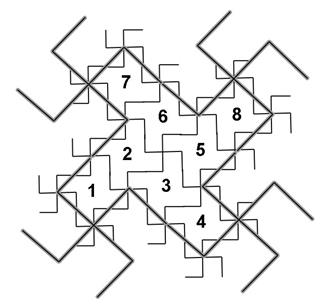
|
|
Figure
5.
Left (a): One set of two orthogonal eigenvectors is used to generate
each layer of pattern. Right (b): The required eight self-similar
regions are displayed, suggesting the method for continuing the
infinite process, using 4-star graphs. It is identical to Figure
2c, generated in the classical manner.
|
Figure
6 shows that the classical method for fractal generation using a
generator on an initiator yields the same result as using shifts
induced by vectors.
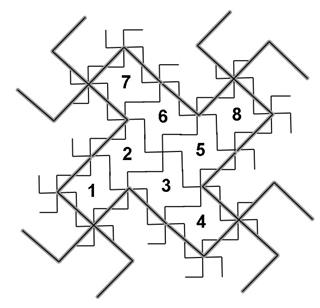
|
Figure 6. Figure 5b, from the
vector approach, is overlain on Figure 2c from the classical approach.
|
Fractally-bounded
Planning?
The
ideas suggested in the iteration sequences in
Figures 4 and 5 might be viewed as broadly similar
to downtown planning: fill an area
with buildings as allowed by zoning, and put in as many roads as
possible to
facilitate movement; superimpose a park if desired, but as an overlay
on
fundamental strategy; and, use the value of D = 2 as the upper bound
beyond
which space-filling by roads is not permitted, except in situations
where there
are multiple vertical layers of street network (beyond the scope of
this broad
suggestion).
One
might determine, in advance, the extent of
permitted space-filling by a road network as, perhaps, a new class of
zoning.
Traditional zoning basically mandates such filling by buildings and
land use
types. Then, one might use the appropriate fractal dimensions,
generated as
absolute (rather than as relative) values based on the iteration of
self-similar generators applied to an initiator. Figure 7 illustrates
how one
might interpret these ideas in a simple landscape, much as Burgess
offered a
simple example, based on the mathematics readily available to him.
In
the central ring of Figure 7, the street pattern
envelope is generated by the iteration sequence of Figure 1; the
initiator is shaded a solid yellow color and is identical to the
initiator in Figure 1. The second frame in the animation sequence in
Figure 1 is displayed in Figure 7 as a blue shape. Grid pattern
is filled in with fractal iteration, as suggested in the animation of
Figure 1. Here, the sequence employed
leads to D = 2
when carried out infinitely (lines would fill everything).
It is truncated here after two steps and its edges form the suggested
road network with streets becoming successively narrower as the pattern
iterates.
In
the outer ring of Figure 7, the street
pattern envelope is generated by the iteration sequence of Figure 2;
The initiator is shaded solid orange. The
second from of the animation yields the brown shape--follow the
generator edges with your eye. Again, narrower streets come from
the edges of smaller (later) iterates. Grid
pattern is filled in through successive generator application. Here the sequence
employed leads to D =
1.0619248 when carried out infinitely (there
would be
gaps between lines—some space would not be filled).
The
two iteration sequences displayed in Figure 7
mesh quite well at the boundary separating one region from the other.
Larger
roads from the core region flow naturally into roads in the rim. Some
of the
more local angled roads in the core region flow into the intersections
of
larger roads along the ring perimeter. These locales might be natural
places to
install traffic circles (avoiding costly traffic lights). In Figure 7,
stars
suggest locations for traffic rotaries, with the largest ones marking
locations
where the largest roads come together, and so forth, creating a
hierarchy of
rotaries marked by stars of various sizes. Others
of the more local angled roads do not
continue into the outer
ring. These roads become natural cul-de-sacs, and offer privacy or
low-profile
needs to specific land use types in the core. In
Figure 7, circles mark the locations of
cul-de-sacs arising naturally in the shift of the underlying grid
dimension. Zoning
might follow the form created by the meshing or failure to mesh of the
underlying geometry, giving parcels on cul-de-sacs special zoning that
reflects
privacy or security concerns.
|
|
|
Figure
7.
Fractally-bounded parcel and road pattern development. The
iteration sequence of Figure 1 generates the road network in the
central circle. The iteration sequence of Figure 2 generates the
road network in the outer ring.
|
The
two-ring pattern displayed in Figure 7 might of
course be extended to include more rings, reflecting variety in zoning
types.
In such extension, traffic circles/rotaries would emerge at boundaries. Cul-de-sacs would emerge in moving from one
ring to another, and, again, zoning patterns might follow their
appearance.
The
generating sequence for the extension of pattern
might be as follows: create a fractal pattern that generates a road
grid, and
then truncate this pattern generation in accordance with parcel size as
determined by land use and zoning. Then, align patterns at the edges of
the
generated adjacent rings. Rings are but one pattern.
Oddly -shaped regions might offer different challenges, but still
the same style of argument might be employed. Typically,
the adjacent patterns do not mesh because
different iteration sequences, reflecting variety in space filling
based on
land use, are employed. One approach, as suggested in Figure 7, might be to align core road network boundary
points and insert traffic circles where appropriate. The left-over
points
become cul-de-sacs, which might be used to advantage for privacy needs
for
residential land uses, for industrial uses wishing a relatively low
profile, or
for a future society less dependent on frequent use of a personal car
and perhaps more dependent on delivery vehicles of various sorts.
Here,
unlike the case of much contemporary urban planning, good reason exists
to
create
cul-de-sacs—as a useful protrusion, unlike an appendix, of an
efficiently
structured network.
The case of Figure 7 was generated using the geometric animations of
Figures 1 and 2. They might equally be generated using the
alternative eigenvalue approach. To determine which approach is
most effective in varying situations is an open question and one that
is currently under study. The answer may lie in what technology
is available to those executing the visualizations.
The
space-filling needs of different zoning
categories produce distinct neighborhoods of road network. Within-ring
accessibility along a grid network is encouraged, while
between-ring
accessibility is reduced, perhaps fostering a safer environment. Such
an
approach also might offer a visual “interest” factor in an otherwise
boring
overall grid pattern. Naturally, one might vary the urban model, the
method for
partitioning urban areas, and the general planning context (beyond
zoning and
land use). Fractally-bounded
characterizations might help to guide real-world planning process when
it is integrated into any conceptual model for urban planning.
REFERENCES
CITED AND RELATED READING
Arlinghaus
S.,
1985, Fractals take a central place, Geografiska
Annaler, Journal of the Stockholm
School of Economics, 67B, pp. 83-88.
Arlinghaus,
S.,
1990, Fractal geometry of infinite pixel sequences: “Super-definition”
resolution? Solstice: An Electronic
Journal of Geography and Mathematics,
Volume I, Number 2. Ann Arbor: Institute of Mathematical Geography. http://www.imagenet.org.
Persistent
URL: http://deepblue.lib.umich.edu/handle/2027.42/58219
 Arlinghaus
S., Griffith
D. 2010. Mapping
it out! A contemporary view of Burgess’s concentric ring model of urban
growth, Solstice, XXI (2), www.mylovedone.com/image/solstice/win10/ArlinghausandGriffith.html Arlinghaus
S., Griffith
D. 2010. Mapping
it out! A contemporary view of Burgess’s concentric ring model of urban
growth, Solstice, XXI (2), www.mylovedone.com/image/solstice/win10/ArlinghausandGriffith.html
Arlinghaus
S.,
Nystuen J., 1990, Geometry of boundary exchanges: Compression patterns
for
boundary dwellers, The Geographical
Review, 80, 1, pp. 21-31.
Arlinghaus
S.,
Nystuen J., 1991, Street geometry and flows, The
Geographical Review, 81, 2, pp. 206-214.
Arlinghaus
S.,
Arlinghaus W., 1989, The fractal theory of central place hierarchies: a
Diophantine analysis of fractal generators for arbitrary Löschian
numbers, Geographical Analysis: an International
Journal of Theoretical Geography, 21, 2, pp. 103-121.
Arlinghaus
S.,
Arlinghaus W., Harary F., 1993, Sum graphs and geographic information, Solstice: An Electronic Journal of Geography
and Mathematics, IV, 1. Ann Arbor: Institute of Mathematical
Geography.http://www-personal.umich.edu/~copyrght/image/solstice/sols193.html
Batty
M.,
Longley P., references listing: http://www.casa.ucl.ac.uk/people/MikesPage.htm
Benguigui
L.,
Daoud M., 1991, Is the suburban railway system a fractal? Geographical
Analysis, 23, pp. 362-368.
Boots,
B.N. and G.F. Rayle, “A
conjecture on the maximum value of the principal eigenvalue
of a planar graph”, Geographical
Analysis,
23(3), 1991, 276-282.
Cardillo,
A., S. Scellato, V. Latora, and S. Porta. 2006.
Structural properties of planar graphs of urban street patterns, Physical Review E, 73: 066107-1 -
066107-8.
Coxeter
H.,
1965, Non-Euclidean Geometry,
University of Toronto Press, Toronto.
Elert
G.,
1995-2007, About Dimension, The Chaos Hypertextbook, http://hypertextbook.com/chaos/33.shtml
Griffith,
D. 2004. Extreme eigenfunctions of
adjacency matrices for planar graphs employed in spatial analyses, Linear
Algebra & Its Applications, 388: 201-219.
Griffith,
D. 2000. Eigenfunction properties and
approximations of selected incidence matrices employed in spatial
analyses, Linear
Algebra & Its Applications, 321: 95-112.
Griffith,
D., and S.
Arlinghaus. 2011. Urban
compression patterns: fractals and non-Euclidean geometries inventory
and
prospect, Quaestiones Geographicae.
Griffith
D.,
Vojnovic I., Messina J. 2010. Distances in residential space:
implications from
estimated metric functions for minimum path distances, unpublished
paper,
School of Economic, Political and Policy Sciences, University of Texas
at
Dallas.
Grünbaum
B.,
Shephard G., 1987, Tilings and Patterns,
W. H. Freeman, New York.
Hausdorff
and
Besicovitch, historical reference: http://en.wikipedia.org/wiki/Hausdorff_dimension
Kansky,
K. 1963.
Structure of Transportation Networks. University of Chicago, Department
of
Geography.
Kim,
K., L.
Benguigui, and M. Marinov. 2003. The fractal structure of Seoul’s
public
transportation system, Cities, 20:
31-39.
Krause
E., 1975, Taxicab Geometry, Addison-Wesley,
Menlo Park, CA.
Li,
J., X. Wang,
and Q-S Guo. 2002. Research on fractal characteristics of urban traffic
network
structure based on GIS, Chinese
Geographical Science, 12: 346-349.
Lu,
Y., and J.
Tang. 2004. Fractal dimension of a transportation network and its
relationship
with urban growth: a study of the Dallas-Fort Worth area, Environment
and Planning B, 31: 895-911.
Mandelbrot
B.,
1983, The Fractal Geometry of Nature,
W. H. Freeman, New York.
Ord
J., 1975, Estimation
methods for models of spatial
interaction, Journal of the American
Statistical Association, 70, pp. 120-126
Park,
Robert I. And Burgess, Ernest W. 1925. The City.
Chicago: The University of Chicago Press.
Rodin
V., Rodina
E., 2000, The fractal dimension of Tokyo's streets, Fractals,
8, pp. 413-418
Shen
G., 1997, A
fractal dimension analysis of urban transportation networks, Geographical
& Environmental Modelling, 1,
pp. 221-236.
Telecs,
A. 1990.
Spectra of graphs and fractal dimensions I, J.
of Theoretical Probability, 8: 77-96.
Telecs,
A. 1995.
Spectra of graphs and fractal dimensions II, Probability
Theory and Related Fields, 85: 489-497.
Thrasher,
F. M. 1923-1926.
Chicago’s Gangland Map. http://www.lib.uchicago.edu/lib/public/full_screen.html?http://www.lib.uchicago.edu/e/su/maps/chisoc/G4104-C6E625-1926-T5
Wikipedia,
Fibonacci Coding: http://en.wikipedia.org/wiki/Fibonacci_coding.
Xie,
Feng;
Levinson, David. Measuring the structure of road networks. Geographical Analysis,
Volume 39, Issue 3, pp. 336-356, July 2007.
*Sandra
L. Arlinghaus, Ph.D., is Adjunct Professor of Mathematical Geography
and Population-Environment Dynamics at The University of Michigan
School of Natural Resources and Environment and also Adjunct Professor
at The University of Michigan Institute for Research on Labor,
Employment, and the Economy (Chene Street History Study); Daniel
A. Griffith, Ph.D., is Professor of Geospatial Information Sciences,
Ashbel Smith Professor in the School of Economic, Political and Policy
Sciences, at the University of Texas, Dallas.
|
